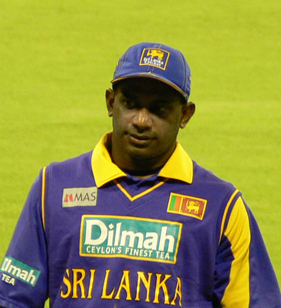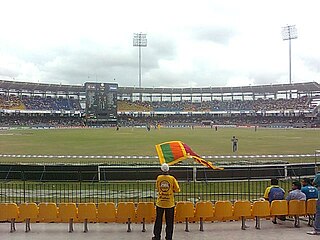
Deshabandu Sanath Teran Jayasuriya, is a former Sri Lankan cricketer and captain, who is widely regarded as one of the greatest all rounders ever to play in ODI cricket. A left arm opening batsman, an orthodox spinner and a dynamic fielder, Jayasuriya together with his opening partner Romesh Kaluwitharana is credited for having revolutionized one-day international cricket with his explosive batting in the mid-1990s, which initiated the hard-hitting modern-day batting strategy of all nations. He was a key member of the Sri Lankan team that won 1996 Cricket World Cup. Under his captaincy Sri Lanka become joint champions along with India in the 2002 Champions Trophy. Currently, he is also the Head Coach of the Sri Lanka National Cricket Team.

Kumar Chokshanada Sangakkara is a Sri Lankan former professional cricketer who represented Sri Lanka from 2000 to 2015. A former captain in all formats. He was born in Matale, Central Province. In first-class cricket, he played for Nondescripts Cricket Club from 1997–98 to 2013–14 and for Surrey County Cricket Club from 2015 to 2017. Sangakkara is widely regarded as one of the greatest cricketers of all time. He was a key part of the Sri Lankan squads which won the 2001-02 Asian Test Championship, 2002 ICC Champions Trophy and 2014 T20 World Cup.

Tillakaratne Mudiyanselage Dilshan, commonly known as TM Dilshan is a former Sri Lankan cricketer and former captain of the Sri Lanka national cricket team. He is often regarded as the best rated Sri Lankan player in run-chases in ODI history and one of the most innovative players of all time. He was the top run scorer in the 2011 Cricket World Cup with 500 runs, and scored a century against England in the quarter-final. Dilshan is considered to be a rare example of a cricketer with notable skills in all aspects of the game, who can bat, bowl, field and keep wicket. He is an aggressive right-hand batsman who invented the scoop, which has come to be known as the Dilscoop, a shot that hits the ball over the keeper. Apart from being an opening batsman, he is also a capable off-break bowler. Energetic in the field, he usually fielded at the point region. He was part of the Sri Lankan team that won the 2014 ICC World Twenty20.

K.D. Singh Babu Stadium, formerly known as the Central Sports Stadium, is a multi-purpose stadium named after the famous hockey player K. D. Singh. The stadium was established in 1957 and it is located near the busy Hazratganj area of downtown Lucknow, in the heart of the city. The KD Singh Babu Stadium metro station lies towards the south-west of the stadium. It has a seating capacity of 25,000. It does support floodlights for day night matches. The stadium is also the home of the Uttar Pradesh cricket team.

The R. Premadasa Cricket Stadium(RPS) (Sinhala: ආර්. ප්රේමදාස ක්රීඩාංගනය, Tamil: ஆர். பிரேமதாச அரங்கம்; formerly known as Khettarama Stadium) is a cricket stadium on Khettarama Road, in the Maligawatta suburb of Colombo, Sri Lanka. The stadium was, before June 1994, known as the Khettarama Cricket Stadium and is today one of the main venues where the Sri Lankan cricket team play, having hosted more than 100 one-day international matches. It is the largest stadium in Sri Lanka with a capacity of 38,000 spectators. It has hosted the 2012 ICC World Twenty20 final between Sri Lanka and West Indies; the 2002 ICC Champions Trophy final between Sri Lanka and India and first semi-final of the 2011 ICC Cricket World Cup between Sri Lanka and New Zealand. This was where the highest Test score in history was recorded; 952 by Sri Lanka against India. With capacity exceeding Lord's in England, the stadium is known as the "home of Sri Lankan cricket".
Sri Lanka toured England for cricket matches during the 2006 international cricket season. England were back home for the first time since September 2005 and looked to maintain their Test standards, which saw them keep their second place in the ICC Test Championship in India, and the teams were also competing for sixth place in the ICC ODI Championship as both England and Sri Lanka were coming off the back of two lost ODI tours on the Asian sub-continent, against India and Pakistan respectively. To add to problems, both teams were likely to be missing some key members of the team as England were without some of their squad for their previous tour and, two days before Sri Lanka departed for England, it was revealed that skipper Marvan Atapattu would stay at home for the tour due to back problems that had forced him to skip his previous tour too. Jehan Mubarak was brought in as his replacement.
The Australian cricket team toured Sri Lanka from 10 August to 13 September 1992 to play three Test matches, three One Day Internationals (ODIs).
The Indian cricket team toured Sri Lanka from 12 July to 14 August 1993. The tour began with a first-class fixture against Sri Lanka Board President's XI and ended with the final ODI game. In all, it consisted of one first-class game, and three Test and One Day Internationals (ODIs) each.
The Indian cricket team toured Sri Lanka in August 1997, participating in two Test matches and three One Day International (ODI) matches. During the first Test match, Sri Lanka scored 952 runs for 6 wickets, the highest team total in Test cricket. Several more records were established in this match, including the highest partnership for the second wicket by Sanath Jayasuriya and Roshan Mahanama. The Test series ended without a result, with both Test matches drawn.
The Sri Lankan cricket team toured South Africa during the 2000–01 season, playing three Tests and six one-day internationals.
The Bangladesh cricket team toured Sri Lanka for three Test matches and three One Day Internationals in June and July 2007. This series held Mohammad Ashraful's first Test and ODI matches as captain of Bangladesh. Sri Lanka ended up winning all the Test matches and One-day Internationals.
The Indian cricket team toured Sri Lanka from 28 January to 10 February 2009. The tour included five ODIs and one T20I. India won the ODI series 4-1 and also the T20I.
The Sri Lankan team toured India from 11 November to 27 December 2009, playing three Tests, five ODIs and two T20Is. The series was called the Jaypee cup.

Pallekele International Cricket Stadium is a cricket stadium in Kandy, Sri Lanka. The stadium opened on 27 November 2009 and became the world's 104th Test venue in December 2010.
The Tri-Series in Bangladesh in 2010 was a One Day International cricket tournament for the Idea Cup which was held in Bangladesh from 4 January to 13 January 2010. The tournament involved the national teams of India, Sri Lanka and Bangladesh. The tournament was won by Sri Lanka who defeated India in the final match which was held on 13 January 2010.
The Indian cricket team toured Sri Lanka, playing three Test matches from 18 July to 7 August 2010.
The knockout stage was the second and final stage of the 2011 Cricket World Cup. It featured the top four teams from each group and contested as a single-elimination tournament. This was the first tournament in which a one-over eliminator would be used to decide matches that finished as ties; however, this decider was not required. India and Sri Lanka reached the final, where India chased down Sri Lanka's total of 274 runs for the loss of just four wickets to claim their second Cricket World Cup title.
The 1996 Singer Cup was a triangular cricket tournament held between 1 and 7 April 1996 in Singapore. The competition featured the national cricket teams of India, Sri Lanka and Pakistan. The tournament was won by Pakistan, which defeated Sri Lanka in the final on 7 April.
The Sri Lankan cricket team toured Australia from 6 December 2012 to 28 January 2013. The tour consisted of three Tests, five One Day Internationals (ODIs) and two Twenty20 Internationals (T20Is). Tests were played for the Warne–Muralidaran Trophy. The Test series was preceded by a match against the Cricket Australia Chairman's XI and Sri Lankans.
The Sri Lanka national cricket team toured India during the 1997–98 cricket season, playing three Test matches and three One Day Internationals (ODIs). Both series were drawn; all three Tests were draws, and each side won one of the ODIs, tying the series 1–1. The other ODI, which was held on 25 December, was abandoned after three overs had been bowled, when after discussion between the two captains and the match referee, it was determined that the inconsistent bounce of the pitch was too dangerous for the players. This was the first occasion on which an international cricket match had been called off for this reason.





